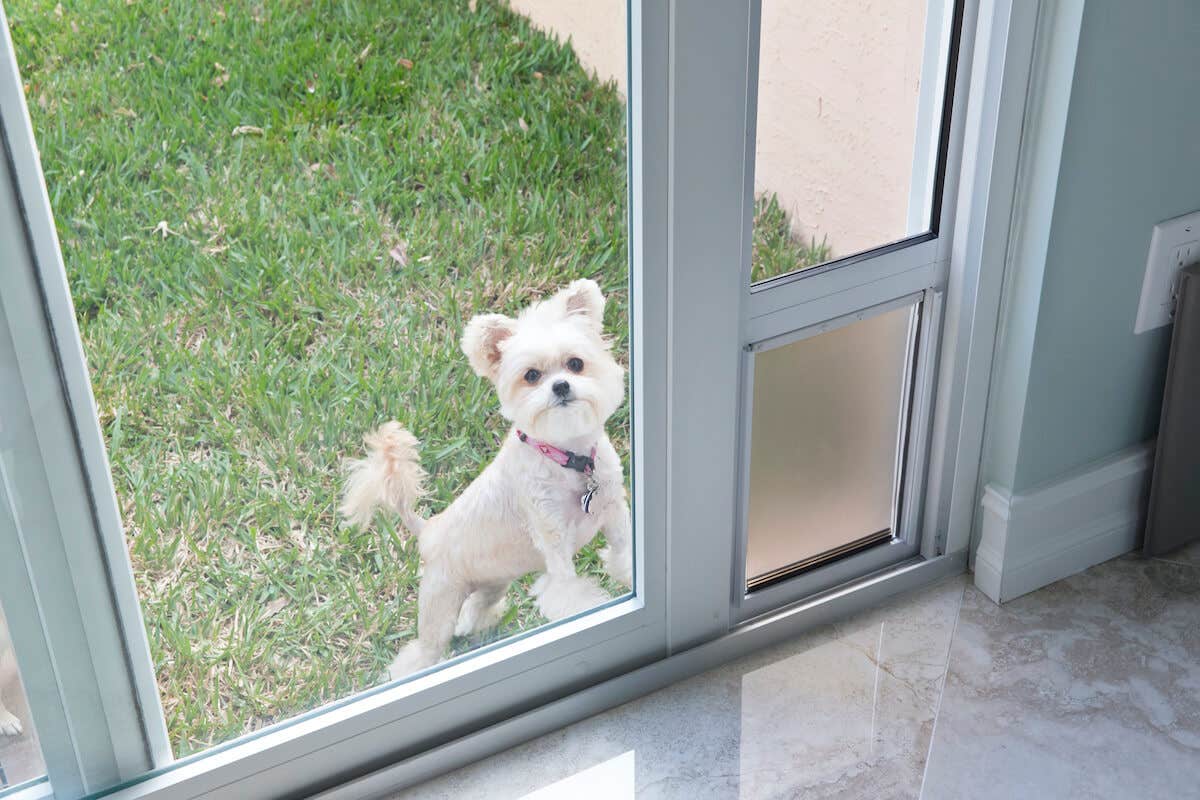Dog doors are a great way to give your canine companion some independence – and you a break from having to constantly let them out – by offering Fido the chance to come and go at will. Finding the right doggy door for your home may take a little bit of research, but the effort is worth it once you find one that saves you on energy bills and keeps you and your pets safe.
Read this before you buy a dog door
Choosing a dog door isn’t as simple as picking one out and having it installed. There are a few factors you want to consider first, such as:
- Cost. We found dog doors for as little as $65, as well as some that cost nearly $2,000. Oddly enough, the high-tech kinds that include a sensor for your dog’s collar weren’t the most expensive.
- Size. Pet doors usually come in four sizes: small, medium, large, and extra large. Pick one that allows your dog to move through it comfortably.
- Security. If you have a large dog, like an Irish wolfhound or a Great Dane, you may end up with a pet door that a person can fit through. Plus, it’s not just potential criminals you need to consider. Small children getting out are also a concern.
- Energy efficiency. A poorly designed or installed doggy door can cause your energy bills to go up.
- Installation. While there are many pet doors you can install on your own, others require the help of a professional.
- Location. You want to make sure your dog or cat can exit your home and enter a safe location, like an enclosed patio or your backyard. This may mean you want to evaluate your fence. Not only do good fences make good neighbors, but they keep your pets safe, too.
One thing you probably won’t have to worry about is your home insurance. As long as your pet door is properly installed and well maintained, then it shouldn’t cause you any headaches when looking for coverage – at least, not with us!
5 types of dog doors
Once upon a time, a dog door was simply a space covered by a flap that let your dog nose its way out of your home. Now you have lots of different options to choose from that we’ve grouped into five categories. Keep in mind that within these groupings, you’ll likely find any number of materials and styles to fit your home.
Energy-efficient pet doors
Some dog doors have lightweight vinyl flaps that can become warped or bent, which may mean they’ll do a lousy job of keeping out the cold and wet. The better idea is to find an energy-efficient option to minimize energy loss. For example, a two-flap system is usually more energy efficient than the traditional single-flap entry.
Most energy-efficient systems also have weatherstripping or an air-tight seal, and many use magnets to help keep the door closed when it isn’t in use. Not only does this help with your energy consumption in the home, but it can also reduce the number of unwanted insects coming in because there aren’t any gaps.
Door-mounted doggy doors
Door-mounted pet doors are what probably first comes to mind when people think about doggy doors. They commonly have a plastic or aluminum frame and a flap for your pet to push when it wants to be outside. Some have two or three flaps to improve energy efficiency.
Door-mounted doggy doors are usually fairly easy to install and for your dog to use. Unfortunately, that means other animals (or worse) may also be able to use it, so you want to look for door-mounted dog doors that have some way of securing the flap.
Wall-mounted dog doors
As the name suggests, a wall-mounted pet door is situated on the wall of your house rather than in a door. This may mean you install it in a hole drilled into the wall or you may end up with a tunnel running from the inside to the outside. Both can be tricky to install yourself, and you may have to patch the wall if you ever decide to move.
Most wall-mounted dog doors come with sealed seams and are weatherproof, features that definitely fall in the plus column. The other big draw for wall-mounted pet doors is that they can be placed in less noticeable locations. That’s good for both curb appeal and security.
Sliding glass door inserts
A sliding glass door insert is a panel that sits on your existing door track and has a dog door pre-installed at the bottom. You place the insert on the tracks, keeping your sliding glass door partially open, and lock it into place. This allows you to use your door as you normally would.
This may be the easiest type of pet door to install, so it’s often less expensive than some of the other options on our list. It’s also a great idea for renters because installation doesn’t require you to cut or drill holes in your unit.
High-tech and electronic pet doors
All of the doggy doors on our list are manually operated by your pet – usually, with just a push of its snout. However, there are also high-tech and electronic pet doors that are ideal for people concerned about security.
For example, some electronic dog doors only open when your dog is nearby reacting to a chip on your dog’s collar. Others have timers that automatically open and close the door. This helps keep out unwanted intruders of both the animal and human varieties.
We know you want to keep your animal companions as secure as possible. Get more safety advice in 12 Tips to Protect Your Pet.


